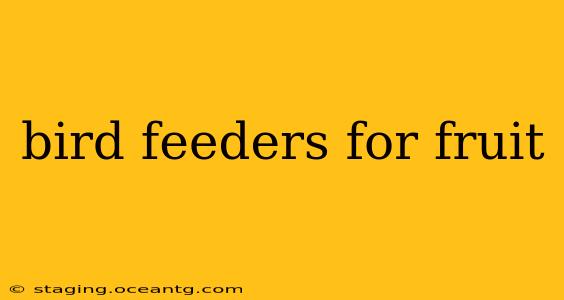Attracting a vibrant array of birds to your backyard is a rewarding experience. While many bird feeders cater to seed-eaters, a dedicated fruit feeder can significantly broaden the range of species you'll attract. This guide explores the best bird feeders for fruit, the types of fruit to use, and essential tips for successful fruit feeding.
What Types of Birds Eat Fruit?
Many birds enjoy a supplementary fruit diet, either seasonally or year-round. These include:
- Woodpeckers: Several woodpecker species enjoy the sweetness of overripe fruit.
- Orioles: Orioles are renowned for their love of fruit, particularly oranges and grape jelly.
- Tanagers: These brightly colored birds are frequent visitors to fruit feeders.
- Robins: While known for their insect-eating habits, robins will gladly partake in berries and other fruits.
- Thrushes: Similar to robins, various thrush species appreciate a fruit-based treat.
- Waxwings: These social birds are especially fond of berries and often congregate at fruit feeders.
What Kind of Bird Feeder is Best for Fruit?
The best bird feeder for fruit will depend on the type of fruit you're offering and the birds you're trying to attract. Here are a few popular options:
- Platform Feeders: These wide, flat feeders are ideal for larger fruits like oranges or apple slices. They are easily accessible to a variety of birds but can also attract unwanted visitors like squirrels.
- Suet Feeders: While primarily used for suet, some suet feeders can also accommodate chunks of fruit, particularly softer options like bananas or berries, mixed in with the suet.
- Mesh Feeders: These feeders hold fruit securely within a mesh bag, preventing messy spillage while allowing birds easy access. They're excellent for berries and smaller fruits.
- Specialized Fruit Feeders: Some manufacturers produce feeders specifically designed to hold fruit. These often incorporate features like perches and drainage to keep the fruit fresh and prevent waste.
What are the best types of fruit for bird feeders?
The best fruits for bird feeders are those that are ripe but not overripe or fermented. This prevents spoilage and potential harm to the birds. Suitable fruits include:
- Oranges: A classic choice, readily available and popular with many birds.
- Apples: Offer a good source of nutrients, but slice them thinly to prevent waste.
- Bananas: Soft and easily consumed, especially appealing to smaller birds.
- Berries: Grapes, blueberries, raspberries, and others are attractive and nutritious.
- Melon: Smaller pieces of cantaloupe or watermelon can work well.
How often should I refill a fruit feeder?
The frequency of refilling will depend on the size of the feeder, the number of birds visiting, and the type of fruit. As a general rule, check the feeder daily and refill as needed, removing any spoiled or fermented fruit to prevent attracting unwanted pests or causing illness in the birds.
What are some tips for keeping fruit feeders clean?
Keeping fruit feeders clean is crucial for the birds' health. Regularly wash the feeder with soap and water, thoroughly rinsing to remove any residue. Allow it to dry completely before refilling.
Can I use homemade fruit feeders?
Absolutely! Homemade fruit feeders offer a cost-effective and creative way to attract birds. Use readily available materials such as repurposed plastic bottles, mesh bags, or even simple plates. Be sure to use sturdy materials and design the feeder to prevent fruit from falling and creating a mess.
What are some fruits to AVOID putting in a bird feeder?
Avoid using avocados, as they contain persin, which is toxic to birds. Also, avoid overly ripe or fermented fruit, which can spoil quickly and attract pests or make the birds sick. Remember to always wash any fruit before placing it in the feeder.
By providing a dedicated fruit feeder and selecting appropriate fruit, you can enhance your backyard bird watching experience and attract a wider variety of colorful species to your garden. Remember to observe the birds that visit your feeder and adjust your offerings to meet their preferences.
